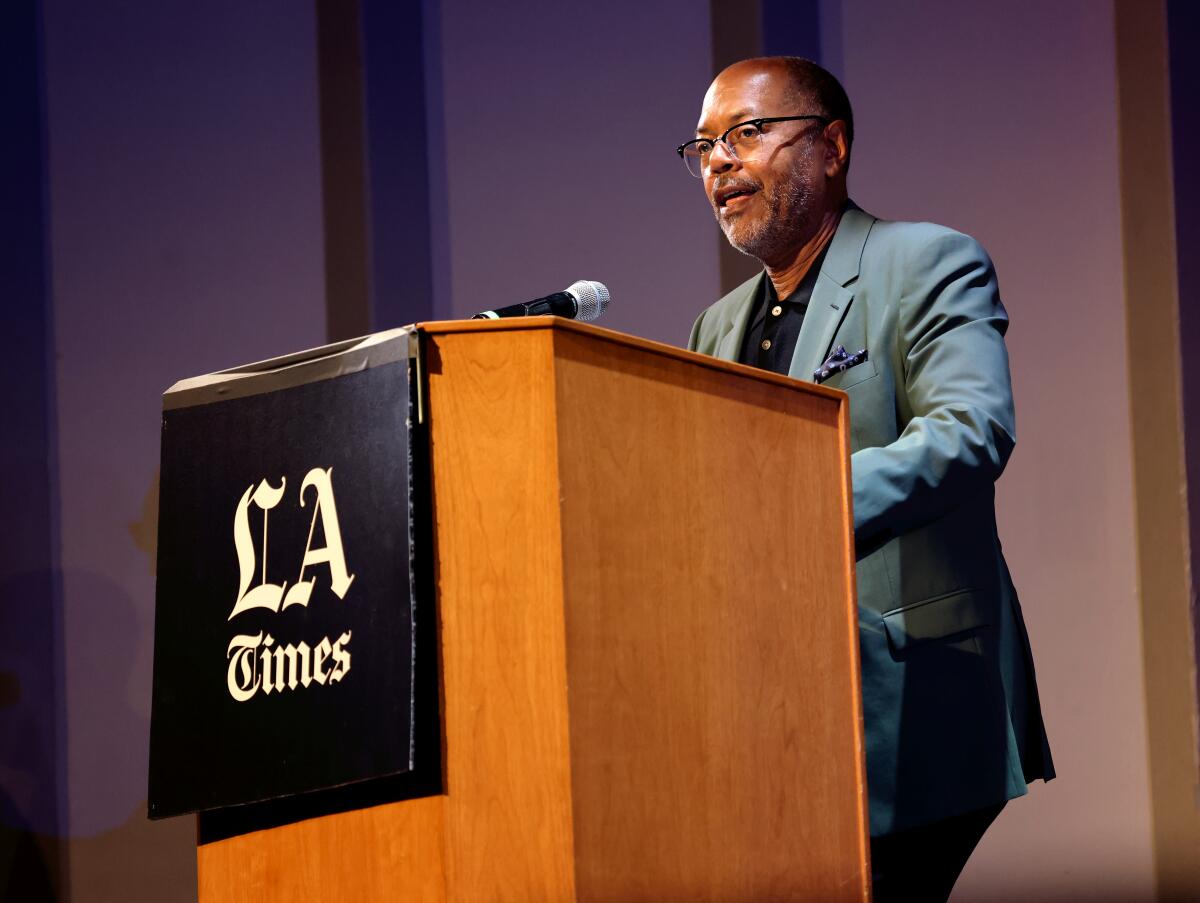Times Executive Editor Kevin Merida is grilled by staff over 73 layoffs

Facing a raw and angry staff stunned by the announcement of 73 layoffs, Los Angeles Times Executive Editor Kevin Merida on Thursday accepted responsibility for making “really difficult decisions” that led to dramatic cuts to the newsroom.
The organization is cutting photojournalists, longtime copy editors, news desk editors who help oversee the paper’s digital report and audience engagement editors. Audio producers were let go, as were a library researcher and several respected managers, including two stalwarts in the Spanish-language Times en Español digital news operation.
“It’s terrible. I feel awful about it but when you’re a leader you have moments like this,” Merida told more than 550 members of the paper’s staff during a Zoom meeting. “We’ll be losing a lot of very valuable people and that’s just really hard to take. It’s hard for me, too.”
The cuts represent the first significant belt-tightening since Dr. Patrick Soon-Shiong and his wife, Michele, paid $500 million to rescue The Times and the San Diego Union-Tribune from Chicago-based Tribune Publishing five years ago. Since then, the Soon-Shiong family has invested tens of millions of dollars in The Times to bolster its journalism and cover revenue shortfalls that have continued each year during their stewardship.
The Times was making strides toward its profitability goals until COVID-19 pandemic closures in 2020 decimated advertising.
Executives initially announced 74 layoffs, but the number was reduced by one on Thursday after a team leader volunteered to go. The Times’ contraction unfolded against a broader backdrop of a newspaper industry in an existential crisis that has prompted dozens of newspapers to fold. Newspapers are starving for advertising revenue, which is being raked in by internet giants, including Google, Facebook and TikTok.
The elimination of about 13% of the newsroom staff is the first major retrenchment since the paper was acquired five years ago by Dr. Patrick Soon-Shiong and his wife, Michele.
Although The Times doesn’t make its finances public, Merida acknowledged that the operation still relies heavily on revenue generated from its printed newspaper at a time of steady print subscriber declines.
And digital revenue has fallen well short of the levels needed to sustain the largest newsroom in the Western U.S.
Merida said The Times was facing a budget gap of “tens of millions of dollars,” which prompted the decision to cut dozens of staff members.
“How can we figure out how to make our business self-sustaining, which is what we have to do,” Merida said. “We’re dealing with structural problems in our industry and holes that cannot be easily filled.”
The veteran journalist said when naysayers would offer him reasons why he should pass on the job, it only made him more eager to come to The Times: ‘I think we’ll shock the world.’
The nearly two-hour session was tense.
Members of the newsroom union, Los Angeles Times Guild, already frustrated by the lack of progress in negotiating a new labor agreement to replace the one that expired in November, said they felt betrayed that management opted for layoffs before first offering buyouts to encourage staff members to voluntarily depart.
“We’ve been evaluating the budget, in real time, since the beginning of the year, and trying to create savings, trying to do things to prevent what is happening now,” Merida said. “It’s on management to make that difficult decision. I want to own the toughness of that, and [not] put that on anybody else.”
There was deep dismay that managers — who have been under fire for years over their level of commitment to newsroom diversity — had proposed cutting so many people of color.
The departures include 34 white people and 39 people of color: 19 Latino people, 11 Asian American people, four Black people and five employees who identify as two or more races.
“This is a setback for us,” Merida acknowledged, noting that management was forced to follow the rules of the labor contract, which requires that layoffs be based on seniority.
“Diversity is always important. We need to look at it in every context of our work… That’s been a lifelong commitment for me, throughout my entire journalism career,” he said.
Merida joined The Times two years ago after several years at ESPN, running the award-winning division formerly known as The Undefeated that plumbed the intersection of race, culture and sports.
He spent more than two decades as a respected reporter then senior editor at the Washington Post, which he grew up reading as a youth in Maryland.
Staff members were upset about the number of Asian American and Latino employees who were let go. The paper’s only two Spanish-speaking photojournalists were initially included in the cuts, which would have left the photo department without a fluent Spanish speaker in a region that is more than 50% Latino. Late Thursday, after an unidentified manager volunteered to leave, one of the Spanish-speaking photographers was reinstated.
Reporters — viewed as the beating heart of the organization — were largely spared. So were the senior-most editors who make up the newspaper’s so-called masthead. Several reporters wondered why a few of the newsroom’s top earners were not included.
“No one from the masthead?” asked investigative reporter Matt Hamilton. “The masthead is the biggest that it’s been since I worked here.”
During the meeting, reporters expressed frustration over Merida’s responses to multiple questions, which they felt didn’t go far enough or were evasive. They demanded to know why so many of the layoffs concentrated on audience engagement editors and web producers who work closely with reporters to build digital audiences for their stories.
“Kevin, you said in your letter that you want us to be a next-generation digital powerhouse,” said Arit John, a national reporter based in Washington. “But how do we do that with ... no audio team, with a decimated audience team and a skeleton crew on the copy desk? These are critical roles.”
Merida responded that not all copy editors or news desk or audience team members were cut, and that there would still be people filling those roles.
The Times gave the 56 guild members 30-day notices. During the next two weeks, other staff members who were not on the list of layoffs can volunteer to take a buyout, which would spare a colleague on the list for the cuts.
But for more than a dozen non-guild members who received termination notices, Wednesday was their last day.
Some speakers became emotional, including journalist Ameera Butt, who was part of the news desk team overseeing the website 24/7 and handling news alerts.
She said that she was working an overnight shift last year in the days leading up to Russia’s invasion of Ukraine, and made a speedy decision to publish a story to keep readers informed. She said her team was integral to making the internet operation more vital to readers.
“I feel incredibly disappointed in management,” Butt said. “It’s been awful. It’s been blindsiding, it’s been a shock because I personally love the L.A. Times and I loved working for you guys and ... that’s gone.”
Merida told her that he was sorry.
“Sorry doesn’t work in this situation,” Butt said.
After the meeting, Merida acknowledged “it has been a difficult two days for our newsroom. I still love our place. Every day, I plan to come to work and do the best I can as a leader.”
More to Read
Inside the business of entertainment
The Wide Shot brings you news, analysis and insights on everything from streaming wars to production — and what it all means for the future.
You may occasionally receive promotional content from the Los Angeles Times.












